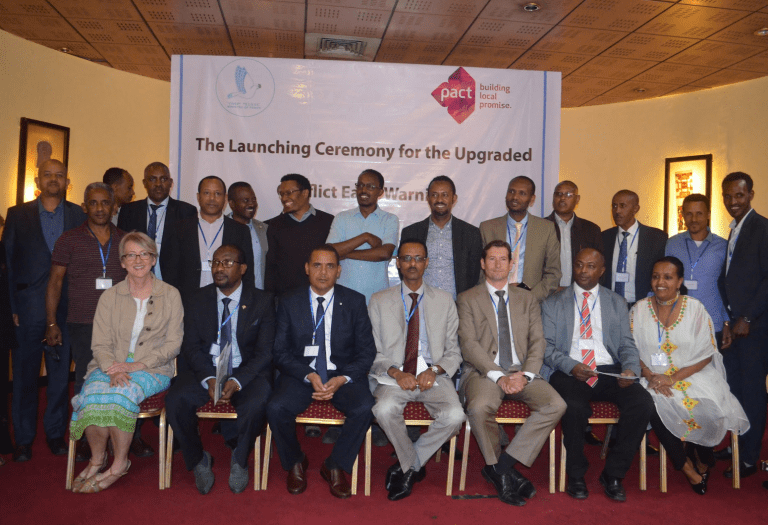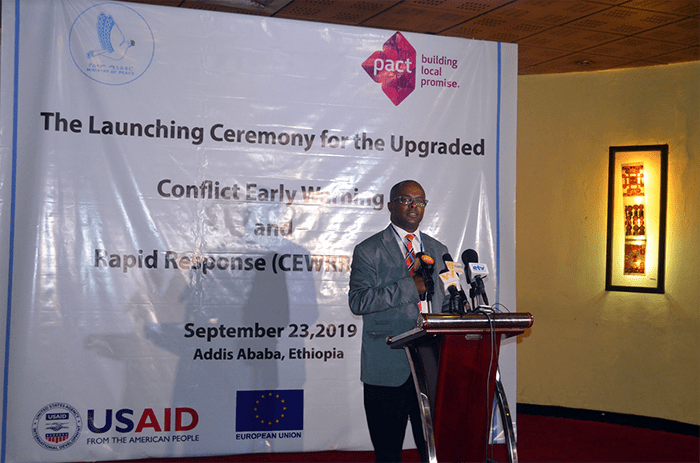Blog
With Pact’s support, Ethiopia Ministry of Peace launches new conflict early warning and rapid response system

Fueled by poverty and tension among the country’s ethnic groups, conflict has long beset Ethiopia. International and Ethiopian partners have worked with the government as Africa’s second most populous nation has made important progress. But until recently, a critical tool for peace was missing: a comprehensive system for quickly detecting and responding to potential conflict.
Late last month, Ethiopia’s Ministry of Peace officially launched the Conflict Early Warning and Rapid Response system, or CEWRR. With funding from a range of international partners, including the European Union, the Dutch Ministry of Foreign Affairs and USAID, Pact is supporting the effort by providing technical guidance, management and monitoring and evaluation services as Ethiopia’s government pilots and scales CEWRR.
Based on an earlier system that has now been significantly upgraded, CEWRR works like this.
Conflict early warning reports enter the system in several ways, and they are broken into two categories. The first category, signals and incidents, are reported as they occur and require rapid response, as they could lead to imminent violence without immediate attention. These reports come from community field monitors, citizens who share information via SMS, and traditional and social media sources.
The second category, situations, require longer-term, sustainable solutions. Unless they are addressed, they could manifest as signals and incidents that become violent conflicts. Situations are reported to CEWRR through regular assessments of specific geographic areas.
The upgraded system’s most important reform is a new response process that uses a case framework. Signals and incidents related to the same conflict source are grouped as a case, and the appropriate government office then rapidly responds. Administrative and security officials at the kebele (or village) level act as initial responders. After kebele officials review a case, they propose a response that is then quickly reviewed by higher-level woreda (or district) authorities. Once a plan is approved, kebele officials take the agreed-upon actions.
If lower-level officials need assistance, they can quickly request it. If their response is successful, they document their actions and recommendations for learning. If it is unsuccessful, the next-higher administrative and security office becomes responsible and proceeds with a proposed response and action.
All of this takes place via CEWRR, where all report and case information is available to administrative and security officials on all levels. This ensure that all potential responders (from kebele to woreda to zone to the regional level) are aware of situations within their jurisdictions, and it helps the next level to rapidly intervene if needed.
In addition to responding to individual cases, CEWRR enables Ethiopian officials to conduct trend analyses to better predict conflict, understand and address root causes, and manage conflict in ways that will build sustainable peace.
CEWRR is being piloted in the regional states of Oromia, Southern Nations Nationalities and Peoples, and Gambella, covering five zones, 12 woredas and 60 kebeles. It will eventually be scaled nationally.
On Sept. 23, Pact and the Ministry of Peace held an event attended by ministers, ambassadors and the media to officially launch CEWRR.
During the event, guests walked through a live demonstration of how information flows from the community, into the CEWRR database and to responders, and they learned about how responses can be escalated all the way to the federal level in extreme cases.
State Minister of Peace Alemayehu Ejigu said CEWRR will be a crucial tool for effective and efficient communication to reduce and prevent conflict in Ethiopia.

Amanuel Mulatu Dibaba, Pact’s country director for Ethiopia, said CEWRR highlighted Pact’s commitment to genuine partnership and capacity building of local organizations in Ethiopia, as the effort relied on local experts from design through installation and launch. He said the project was an exemplary partnership among the government, an NGO, donors and local communities, which allowed for a successful exchange of ideas, experience and resources to realize an important strategic vision that will mean greater stability and prosperity across Ethiopia and the Horn of Africa.
Dibaba called on the Ministry of Peace to take full ownership of CEWRR, to use the system to the fullest extent and to provide the strategic leadership and additional resources needed to build lasting peace.

Representatives from CEWRR’s three major donors also spoke, congratulating the Ministry of Peace for reaching this critical point. They included Scott Hedlund, Office Chief, Democracy and Governance at the USAID Mission in Ethiopia; Luca Zampetti, Deputy Head of the European Union Delegation in Ethiopia; and Chris Devillers, Deputy Permanent Representative and Counsellor at the Embassy of the Kingdom of the Netherlands in Addis Ababa.
Pact has implemented more than 40 projects in Ethiopia in partnership with the government and more than 100 indigenous organizations across the country.